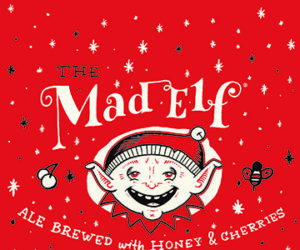Cranberry Cream Ale
 Cranberry Cream Ale
Cranberry Cream Ale
(5 gallons/19 L, extract with grains)
OG = 1.054 FG = 1.012
IBU = 26 SRM = 4 ABV = 5.6%
Ingredients
5 lbs. (2.23 kg) extra light dried malt extract
0.5 lb. (0.23 kg) dextrine malt
0.5 lb. (0.23 kg) light crystal malt (20° L)
1 lb. (0.45 kg) rice syrup (or 0.75 lb./0.34 kg rice syrup solids)
4.5 AAU Liberty hop pellets (45 min.) (1 oz./28 g at 4.5% alpha acids)
6 AAU Cascade pellets (15 min.) (1 oz./28 g at 6% alpha acids)
4 lbs. (1.8 kg) frozen, whole cranberries
White Labs WLP080 (Cream Ale) or Safale US-05 or Wyeast 2112 (California Lager)
7/8 cup corn sugar (if priming)
Step by Step
In 3 gals. (11 L) of cold water, steep dextrine and light crystal malt. Raise temperature slowly to 170 °F (77 °C), then remove grains. Add to kettle dry malt extract and rice syrup (or rice syrup solids). Bring to a boil. Add Liberty hops and boil 30 minutes. Add Cascade hops and boil 15 minutes. Remove from heat, chill, and add to primary fermenter with enough pre-boiled cold water to make up 5.25 gals (20 L).
At 75 °F (24 °C), pitch a neutral ale yeast or lager yeast that does well at warmer temperatures. Ferment on the cooler side of ale temperatures (60 to 65 °F/16 to 18 °C).
After initial fermentation has slowed down, rack into a secondary onto whole cranberries (frozen for at least a week, let thaw and bruise them to break skins before placing them in the fermenter). Some new fermentation will probably begin, so you may find you need to use a blow-off setup for a day or so. Condition at fermentation temperature for about two weeks, then rack into a keg or bottling bucket. Bottle, priming with dextrose. Bottle condition three weeks and serve chilled.
Notes and Alternatives:
All-grain brewers:
This is a standard light, golden ale recipe, somewhere in the neighborhood of 9 lbs. (4.1 kg) brewers’ malt while maintaining the same level of specialty grains, as above, with 0.5 lb. (0.23 kg) dextrine and 0.5 lb. (0.23 kg) light crystal. Keep it light.
Cranberries:
If you really get stuck and can’t find cranberries, do not use a bottled cranberry juice cocktail or similar juice as a substitute. Most of them are blends of cranberry, apple, and white grape juice and will not produce the desired tartness. Pure (preferably organic) cranberry juice may be used in a pinch, but it is almost as hard to find sometimes as the berries themselves. Some of the wine-making trade suppliers sell a cranberry flavoring essence. Ask your homebrew supply store if it carries an essence or can find one. I have used one of them and was pleased with the results, although the fresh fruit will always be a better choice, to my mind.
Fining:
If you decide that the fruit treatment described above is not sanitary enough for you and you decide to pasteurize the fruit, be careful not to boil it because cranberries contain pectin and will turn your beer hazy given the opportunity. But if this happens, you can certainly use whatever finings you would normally use in the secondary.
Written by Scott Russell
For a tart twist on a cream ale, the addition of cranberries will provide an astringency and acidity and can play nicely in this style.
 Cranberry Cream Ale
Cranberry Cream Ale

